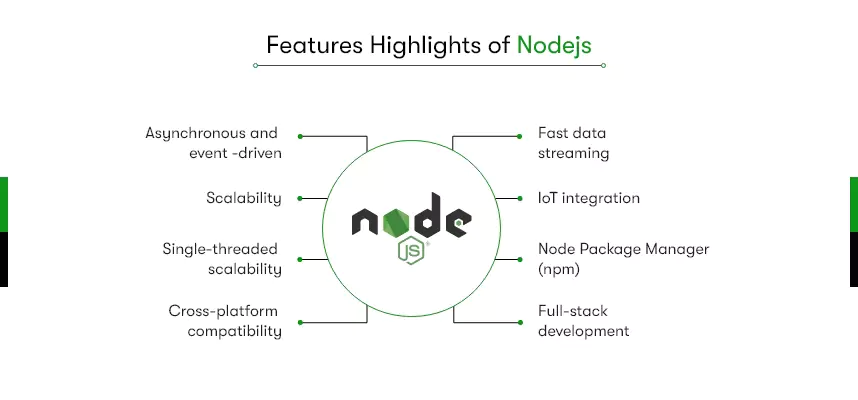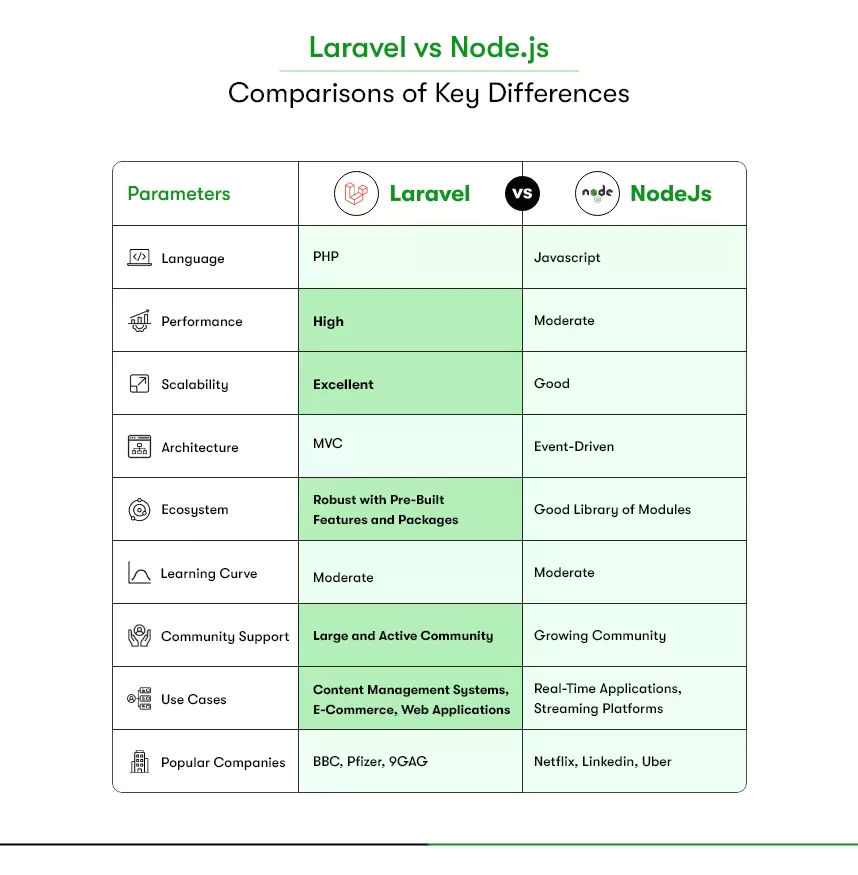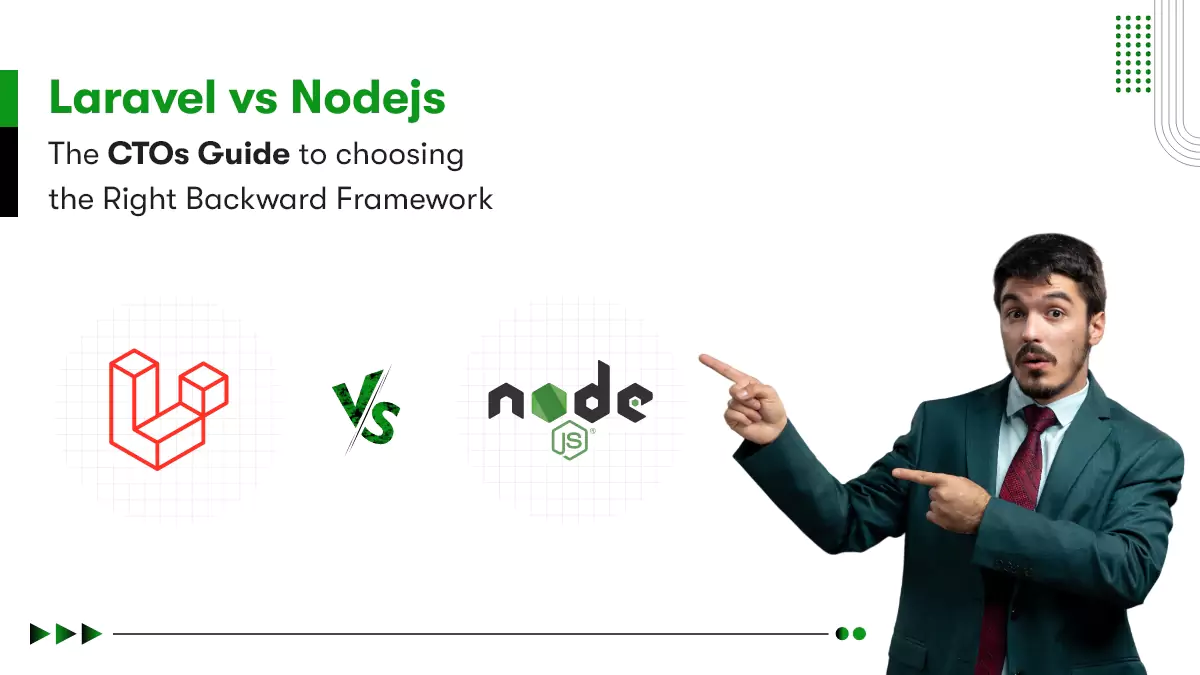Every project owner wants to choose the best framework for their project. But when a study says, Laravel is the most popular backend development framework, while another states Node.Js as the most used framework, not only CEOs but CTOs also get confused.
Because the fear of choosing the wrong is real irrespective of Laravel vs. Node.Js! The whole development cycle, from hiring app developers to third-party API integrations, everything depends on it.
What if you choose Node.Js when Laravel is the best fit? It can impact the scalability and performance of your application, potentially leading to bottlenecks, inefficiencies, and difficulties in handling high user loads.
To avoid this dilemma, however, you can learn about both technologies. Conduct Laravel vs. Node.Js comparison to a deeper level and figure out which one ticks all the boxes of your requirements.
And to do that, this post can be your ally.
One by one, this post reveals valuable insights into Laravel vs. Node.Js for backend development. With the hope that by the end of the post, you can make a data-driven decision, let’s begin!
Snapshot of Laravel
Laravel is a free and open-source web development framework by Taylor Otwell to build PHP-based websites from scratch rapidly. The framework is more famous for offering cutting-edge features. One of the most praised characteristics of Laravel is that it allows you to use components from various frameworks, including Ruby on Rails, CodeIgniter, and Yii.
Besides, the PHP-based web development framework can also maintain the project’s directory structure, applying appropriate security measures. In addition to offering a simple Laravel development environment, it has a growing number of packages, empowering developers to add more functionalities seamlessly.
Now that you have a little acquaintance with Laravel, let’s introduce you to features that make Laravel the most popular web development framework.

Feature highlights
- Eloquent ORM: Laravel provides a powerful Object Relational Mapper (ORM) called Eloquent for seamless database interactions.
- Database Migrations: It offers built-in mechanisms for creating and managing database migrations, making it easier to modify database structure.
- Artisan CLI: With Laravel’s command-line tool, Artisan, developers can bootstrap models, controllers, and other application components, speeding up the development process.
- Containerization Support: Laravel can be used in a containerized development environment, allowing for better portability and scalability.
- Extensive Ecosystem: It has a vast ecosystem of packages and extensions that developers can leverage to enhance their applications.
- Blade Templating Engine: Laravel utilizes the Blade templating engine, which simplifies the process of designing and rendering views.
- Authentication and Authorization: Laravel provides a straightforward way to implement authentication and authorization in web applications.
- Caching: It offers a caching system that helps improve application performance by storing frequently accessed data.
- Routing: Laravel’s routing system allows developers to define clean and easily maintainable routes for their web applications.
Types of applications Laravel is best suited for
- Static and dynamic web pages
- Single-page applications (SPAs) and multi-page applications (MPAs)
- eCommerce websites
- Enterprise-level Applications
- Portal web apps such as forums, job portals, news websites, etc.
- Content management systems
- Social networking sites
These are just a few notable features and use cases of Laravel, which contribute to its popularity and make it a preferred choice among developers for PHP web development. Now, let’s forge toward Node.Js.
Read Also: Top 25 Sites Built with Laravel Framework
Snapshot of Node.Js
Node.js is an open-source, server-side JavaScript runtime environment built on Chrome’s V8 JavaScript engine. It allows developers to run JavaScript code outside of a web browser, making it possible to use JavaScript for server-side scripting and backend development.
Node.js provides an event-driven, non-blocking I/O (input/output) model, which allows it to handle a large number of concurrent connections efficiently. This makes it well-suited for building scalable and high-performance network applications.

Features highlights
- Asynchronous and event-driven: Node.js leverages non-blocking APIs and event mechanisms for efficient, time-sensitive applications.
- Full-stack development: With Node.js, you can develop both the front and back end using JavaScript.
- Single-threaded scalability: Node.js’ event loop architecture allows for high scalability and handling of more requests.
- Cross-platform compatibility: It works on Windows, Unix, Linux, Mac OS X, and mobile platforms, making it versatile.
- Fast data streaming: Node.js supports lightweight and native streaming, enabling direct transmission of data.
- IoT integration: Node.js is memory-efficient, making it ideal for concurrent connections in IoT applications. It also supports the MQTT protocol.
- Node Package Manager (npm): npm is a robust package manager that simplifies the installation and management of application packages.
- Scalability: Node.js’ asynchronous nature allows it to handle multiple requests concurrently, making it highly scalable.
Laravel vs Node.js Comparisons of Key Differences

Programming language differences of Laravel vs. Node.Js
Laravel is a PHP framework, which means it utilizes the PHP programming language for backend development. PHP is a widely used server-side scripting language known for its simplicity and versatility.
Node.js, on the other hand, is a JavaScript runtime environment. It allows developers to execute JavaScript code outside of the browser, enabling them to build both frontend and backend applications using JavaScript.
Laravel vs. Node.js Performance Analysis
Laravel is known for its robustness and stability. It provides a strong foundation for building complex web applications with heavy business logic. Its performance is optimized for handling tasks that involve data processing, database interactions, and server-side rendering.
Use case: Laravel is commonly used for developing enterprise-level applications that require complex workflows, extensive database operations, and secure user authentication.
Node.js is highly performant and efficient, particularly for handling concurrent connections and real-time applications. It utilizes an event-driven, non-blocking I/O model, which allows it to handle multiple requests simultaneously without blocking other operations.
Use cases: Node.js is well-suited for developing real-time chat applications, multiplayer online games, collaborative tools, and streaming platforms that require fast and responsive communication between the server and clients.

Architectural differences between Laravel vs. Node.Js for backend development
Laravel follows the Model-View-Controller (MVC) architectural pattern, which provides a structured approach to organizing code and separating concerns. It promotes code reusability, modularity, and scalability by dividing the application into models (data layer), views (presentation layer), and controllers (business logic layer).
That’s why– Laravel developers can easily manage different components of a web application, such as handling user requests, manipulating data in the database, and rendering dynamic views based on the data.
Also, learn how to hire Laravel developers with this simplest detailed guide!
Node.js allows for more flexibility in architectural choices. While it can be used with frameworks like Express.js, which follows a middleware-based architecture, Node.js itself does not enforce any specific architectural pattern. Developers have the freedom to design the backend architecture according to their project’s requirements and preferences.
That’s why– Node.js can be used to build microservices-based architectures, where different components of the application are developed as separate services that communicate with each other via APIs.
Who has the best Scalability in Laravel vs. Node.Js?
When it comes to scalability, both Laravel and Node.js have their strengths. However, Laravel shines in terms of scalability due to its robust architecture and extensive ecosystem.
With features like caching, database optimization, and queuing systems, Laravel offers a solid foundation for building scalable web applications that can handle increased traffic and growing demands.
Which one between Laravel vs. Node.Js is suitable for what?
As discussed earlier, Laravel development is well-suited for building web applications with complex business logic, content management systems, and enterprise-level applications. Its rich ecosystem, including features like routing, authentication, and database ORM, makes it a popular choice for building robust and customizable applications.
Example: Laravel is commonly used for developing e-commerce websites, customer relationship management (CRM) systems, and enterprise resource planning (ERP) software.
Node.js is suitable for real-time applications, streaming platforms, chat applications, and applications that require high scalability and concurrency. Its event-driven architecture and non-blocking I/O make it ideal for building applications that need to handle a large number of concurrent connections and provide real-time updates.
Example: Node.js is commonly used for developing chat applications, collaborative tools, real-time dashboards, and streaming platforms like video streaming or music streaming services.
Laravel vs. Node.Js: What Expertise to Look for in your team?
For Laravel, look for developers experienced in PHP, Laravel framework, Model-View-Controller (MVC) architecture, Eloquent ORM (Object Relational Mapping), Blade template engine, and database interaction using SQL or Eloquent queries.
For example, a Laravel development team should have expertise in building RESTful APIs, implementing authentication and authorization systems, optimizing database queries, and working with Laravel’s built-in packages and tools.
On the other hand, for Node.js, look for developers experienced in JavaScript, Node.js runtime environment, asynchronous programming with callbacks or promises, event-driven architecture, popular libraries/frameworks like Express.js, and working with APIs and server-side JavaScript.
For example, a Node.js development team should be skilled in building scalable and efficient server-side applications, working with databases using frameworks like Sequelize or Mongoose, implementing real-time communication using WebSockets or Socket.IO, and optimizing application performance through event-driven programming.
How can you ensure the correct selection between Laravel vs. Node.Js?
Ensuring the correct selection between Laravel and Node.js requires careful consideration of several factors. Following these insightful steps and considering the unique characteristics of your project, you can make an informed decision between Laravel and Node.js.
Analyze project requirements:
Start by understanding the specific needs and requirements of your project. Consider factors such as the type of application, expected traffic, real-time functionality, scalability needs, and development timeline.
Evaluate developer expertise:
Assess the expertise and experience of your development team or the resources available to you. Determine the level of proficiency in PHP and Laravel for Laravel development, or JavaScript and Node.js for Node.js development. Consider their familiarity with the frameworks, architectural patterns, and best practices associated with each technology.
Consider performance characteristics:
Evaluate the performance characteristics required for your project. Laravel is well-suited for applications that involve complex business logic, data processing, and server-side rendering. Node.js excels in handling concurrent connections and real-time communication due to its non-blocking, event-driven nature.
Assess ecosystem and libraries:
Explore the ecosystem and available libraries for each technology. Laravel has a mature ecosystem with a wide range of packages and extensions, offering prebuilt solutions for various functionalities. Node.js has a vast library of JavaScript modules and a vibrant community, providing extensive support and resources for different use cases.
Evaluate scalability requirements:
Consider the scalability needs of your project. Node.js, with its non-blocking architecture, is known for handling a large number of concurrent connections efficiently. If your application requires real-time updates or expects significant traffic growth, Node.js might be a better fit. However, Laravel can also scale effectively with proper optimization and architectural design.
Consider team collaboration and preferences:
Take into account the collaboration dynamics within your team. Evaluate their preferences, strengths, and familiarity with either PHP or JavaScript. Consider the ease of code maintenance, debugging, and long-term support for your project.
Community support and documentation:
Examine the level of community support and availability of documentation for both Laravel and Node.js. A strong and active community can provide valuable resources, troubleshooting assistance, and updates for the technology you choose.
Project timeline and constraints:
Consider the timeline and constraints of your project. Evaluate the development speed and efficiency that each technology offers. Laravel’s built-in features and code generation tools like Artisan CLI can accelerate development. Node.js, with its ability to use JavaScript for both frontend and backend, may streamline development for full-stack developers.
Future scalability and maintainability:
Look into the long-term scalability and maintainability aspects. Consider factors such as the availability of skilled developers, future updates, community trends, and the technology’s roadmap. Choose the technology that aligns with your long-term goals and ensures sustainable development.
Ready to make the right choice?
The right choice for you will depend on your specific needs and requirements. If you need a framework that is well-documented, easy to learn and has a large and active community, then Laravel is a good choice. However, if you need a framework that is very fast and scalable and is excellent for real-time web applications, then Node.js is a good choice.
If you are not able to decide, the best option is to get a consultation from experts before taking any other step.












 Contact Information
Contact Information